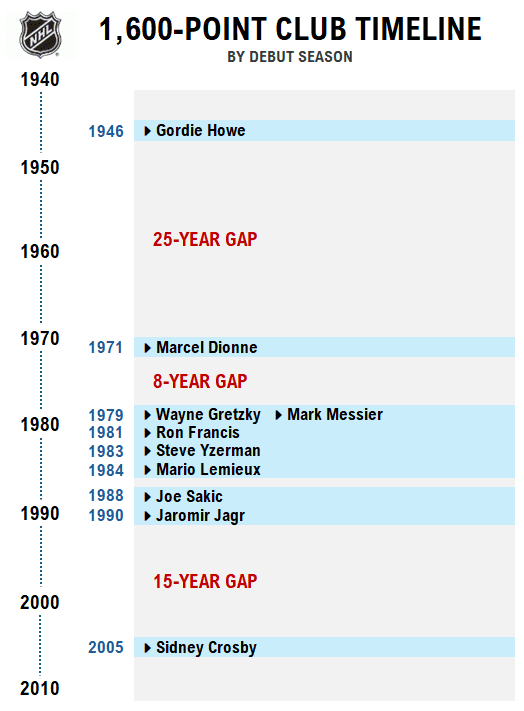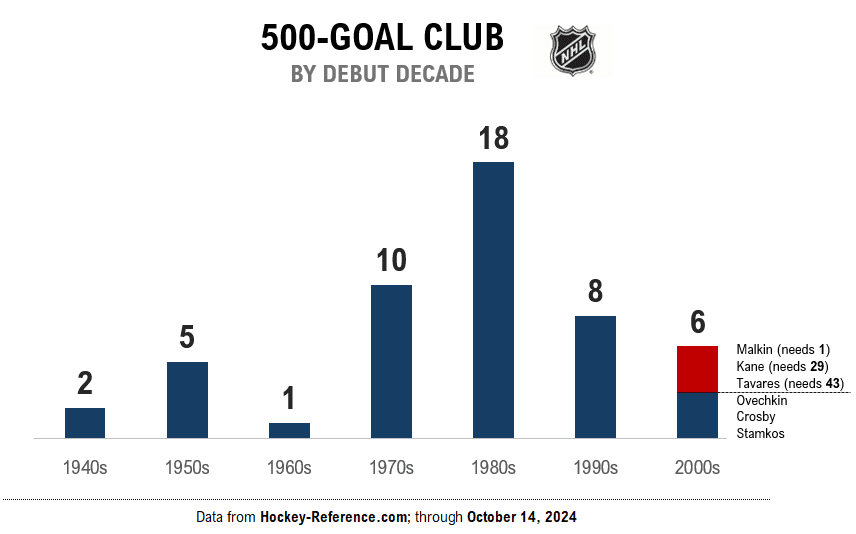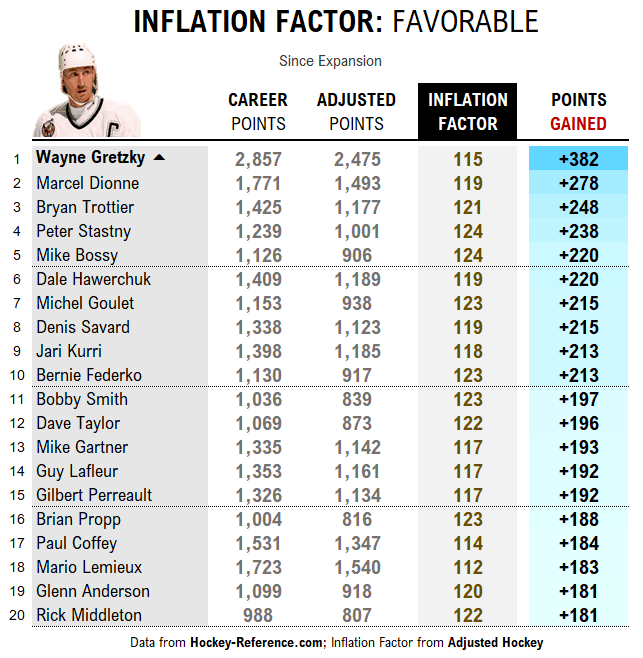Sidney Crosby, 1,600 points, and the lost generation of scoring sensations

One day this week, Pittsburgh Penguins captain Sidney Crosby will become the 10th player in NHL history to reach 1,600 points.
At first, that sounds about right. Crosby has made up for career-threatening injuries in his mid-20s by remaining healthy, consistent, and productive into his 20th season. His legacy is safe, his achievements well-documented. #87 will retire as one of the best players to ever live — how high he ranks on the list is in the eye of the beholder.
But the next question shifts to how the preeminent scorer of his time took two decades to reach a milestone that nine others have already hit.
We’re exploring a lost generation today. A 20-year window of scoring talent that’s rarely seen at the top of NHL leaderboards, short of major milestones, and with legacies that undersell their brilliance.
The 1,600-Point Club
We’ll start with the 10 players to score 1,600 points. Here’s a timeline by debut season, beginning with the godfather of perpetual excellence, Gordie Howe.

The two major gaps here are remarkable, helping tell the story of the NHL’s scoring environment.
Howe debuts… the schedule grows from 60 to 70 to 80-plus games… offense explodes… eight members of the 1,600-point club debut between 1971 and 1990… scoring craters… Crosby debuts.
The NHL has been around for 107 years. Yet, half its 1,600-point players — Gretzky, Messier, Francis, Yzerman, Lemieux — debuted in a five-year window. It’s the same with defensemen. All five of the top point-scoring defensemen in league history — Ray Bourque, Paul Coffey, Al MacInnis, Phil Housley, and Larry Murphy — were rookies between 1979 and 1982.
It’s a hardly a coincidence. And it’s not their fault for scoring a lot. But the group arrived amidst a preposterous imbalance of offense vs. defense, before the NHL had globalized, and during rapid expansion. A time of endless power plays and save percentages in the .870s and .880s.
The Lost Generation of Scorers (1996-2015)
Alex Ovechkin should join Crosby this season, needing a 50-point year to become the 11th player to 1,600 points. Ovechkin has missed only 51 games in 20 seasons, a 97% attendance figure. An inconceivable rate for a man who played so hard at his peak.
Yet, despite the advances in fitness, nutrition, sports medicine, and a gradual decline in dangerous hits — which collectively should extend careers — not one player that debuted in the 15-year window between Jagr and Crosby/Ovechkin scored 1,600 points.
Not Teemu Selanne in 21 seasons.
Not Joe Thornton in 24 seasons.
Not Jarome Iginla in 20 seasons.
Evgeni Malkin, who debuted in 2006, just passed 1,300 points. He’s 38 years old. Patrick Kane, the 2007-08 Calder Trophy winner, is more than 300 points shy and nearing his 36th birthday. Neither has a realistic path to the 1,600-point milestone.
Had these players performed the same relative to the league 10, 20, or 30 years earlier, they’d be remembered much differently. That’s the reality of how scarce goals were from the mid-1990s through the mid-2010s. Crosby, who has scored at will since he was a teenager, and Ovechkin, a herculean talent that rarely missed a game, each needed 20 years to hit a mark that seven guys born 12 years apart achieved.
But Crosby and Ovechkin don’t need more praise. Both are pursuing Gretzky records. They’ve been so great they’ve overcome the seismic scoring disadvantages of their time — low-offense climate, pandemics, lockouts. It’s that next tier of superstars that have been greatly overshadowed.
The Disappearing 500-Goal Scorer
Consider the 500-goal club. There are 47 members in NHL history, broken down by decade of debut below.

To date, there are only three players who debuted in the decade of 2000-2009 with 500 career goals. Malkin needs one goal and will be the fourth. We’re going to assume that Patrick Kane and John Tavares get there, needing 29 and 43 goals, respectively.
But as Bob Cole would say “Surely… that’s gotta be it!”
- Corey Perry (430 goals) doesn’t have 70 more left in him.
- Anze Kopitar (422 goals), at age 37, is a stretch having averaged 24 goals the last three seasons.
- Phil Kessel (413 goals) is now playing professional poker, so we too should know when to fold’em.
- Brad Marchand (401 goals) would need a lot to go right at his age and injury history.
So, after an average of 12 players in the three previous decades, the 2000-2009 rookie crop will yield, at most, six 500-goal scorers. This was once a milestone so routine that 14 players scored #500 in an eight-season span.
In even a neutral scoring climate, let alone a favorable one, Joe Pavelski (535 era adjusted goals), Jeff Carter (508), and Eric Staal (507) would have made nine members from the 2000s. In an era that didn’t suppress offense, Rick Nash, Ilya Kovalchuk, Zach Parise, Perry, Kopitar, Marchand, and Jamie Benn may have reconfigured their retirement plans with 500 goals in plain sight.
Instead, we’re left with only Ovechkin, Crosby, Stamkos, Malkin, and probably Kane and Tavares. The pre-and-post-lockout crop of superstars is largely shut out from what was long a reachable milestone.
Inflation Factor
Inflation can be a nasty word. Every developed country experienced a severe case from the disruption of supply chains after the pandemic. Hockey stats aren’t immune, either.
To illustrate the impact of scoring climate on career stat lines across generations, we’re going to use a stat I created called Inflation Factor. In short, a player’s Inflation Factor is a simple calculation, expressing their career point totals as a percentage of their career era adjusted point totals.
- If a player’s Inflation Factor is 100: their career was played in a neutral scoring climate.
- If a player’s Inflation Factor is below 100: their career was played in an unfavorable scoring climate.
Example: Erik Karlsson’s Inflation Factor is 92 — Karlsson’s totals are deflated by 8%. - If a player’s Inflation Factor is above 100: their career was played in a favorable scoring climate.
Example: Wayne Gretzky’s Inflation Factor is 115 — Gretzky’s totals are inflated by 15%.
Let’s see Inflation Factor in action, identifying the players most affected by the timing of their careers.

As we expected, players peaking in the 1996-2015 period have been most negatively affected by poor timing. Sure, they’ve made a lot more money than their predecessors. But their stat lines are deflated. Players like Jagr, Kane, Ovechkin, Thornton, and Crosby are among the most impacted, a logical trend give both the timing of their careers and the size of their point totals.

On the reverse, you’ve got the Boomer generation that arrived on time when it came to production. Gretzky unsurprisingly benefitted most — the sport’s greatest point-producer peaking when goals were flying. The swing in Inflation Factor between Claude Giroux (90) and Jari Kurri (118), for example, is eye-opening. Giroux is shorted 10%, while Kurri benefitted 18%, rendering their era-relative totals nearly identical despite a 332-point(!) lead by Kurri on paper.
Closing Thoughts
The new era of Gen-Z scorers, led by Nathan MacKinnon (debut 2013), Leon Draisaitl (2014), Connor McDavid (2015), and Auston Matthews (2016) will continue to fly up NHL career leaderboards. Maybe one of them will reach 1,600 points, McDavid easily being the most likely at this stage.
But they too have been adversely affected by timing — a half-season lost between the pandemic-shortened years, plus a fairly neutral scoring climate overall. Each has an Inflation Factor of 93 — comparable to the Crosby/Ovechkin era a decade before. Their factors should rise gradually as the bulge in scoring the last few seasons improves their fortune overall.
But while we can’t unsee a player’s scoring totals, it’s clear we need to look closer.
The 15-year gap in the debuts of 1,600-point scorers Jagr and Crosby screams how special the feat is today. But it also reminds us to appreciate the lost generation that shared the ice with them. Thornton, Iginla, Malkin, Kane, Stamkos headline the many gifted scorers born into an NHL at the wrong time for offense.
Follow @AdjustedHockey on X; visit www.adjustedhockey.com
Recently by Paul Pidutti
- The 10 greatest forward seasons of the salary cap era
- Inside Hockeyville: What it’s like when the NHL comes to your town
- Which superstars deserve to have their Hall of Fame waiting periods waived?
- Why Connor Bedard’s sophomore ceiling is much higher than you think
Article presented by Amazon Prime

This Article is a Presentation of Prime Video. Catch Prime Monday Night Hockey, all season long. Claim your free trial today.
More from Paul Pidutti
- Generational Talent Watch: Schaefer, Celebrini, Bedard and Carlsson producing at historic levels
- Father Time 2025: Are McDavid, Binnington and others on the decline?
- Surprise: great players rarely make great NHL coaches
- Overtime, loser points unleashing chaos in NHL’s Season of Parity
- Projecting the 2026 Hall of Fame Class: Bergeron, Price and endless possibilities